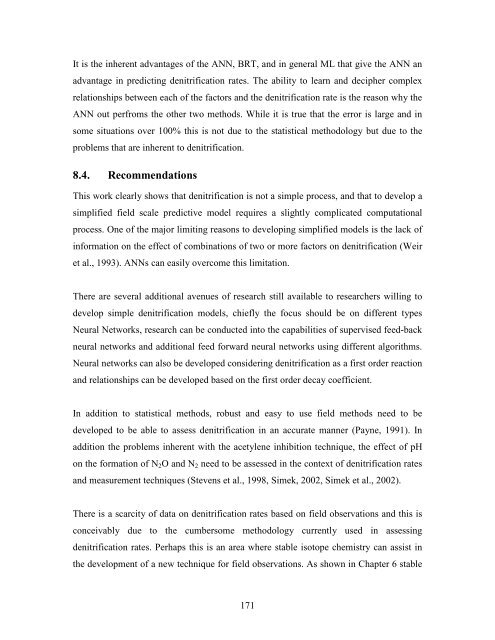THE FLORIDA STATE UNIVERSITY ARTS AND SCIENCES ...
THE FLORIDA STATE UNIVERSITY ARTS AND SCIENCES ...
THE FLORIDA STATE UNIVERSITY ARTS AND SCIENCES ...
Create successful ePaper yourself
Turn your PDF publications into a flip-book with our unique Google optimized e-Paper software.
It is the inherent advantages of the ANN, BRT, and in general ML that give the ANN an<br />
advantage in predicting denitrification rates. The ability to learn and decipher complex<br />
relationships between each of the factors and the denitrification rate is the reason why the<br />
ANN out perfroms the other two methods. While it is true that the error is large and in<br />
some situations over 100% this is not due to the statistical methodology but due to the<br />
problems that are inherent to denitrification.<br />
8.4. Recommendations<br />
This work clearly shows that denitrification is not a simple process, and that to develop a<br />
simplified field scale predictive model requires a slightly complicated computational<br />
process. One of the major limiting reasons to developing simplified models is the lack of<br />
information on the effect of combinations of two or more factors on denitrification (Weir<br />
et al., 1993). ANNs can easily overcome this limitation.<br />
There are several additional avenues of research still available to researchers willing to<br />
develop simple denitrification models, chiefly the focus should be on different types<br />
Neural Networks, research can be conducted into the capabilities of supervised feed-back<br />
neural networks and additional feed forward neural networks using different algorithms.<br />
Neural networks can also be developed considering denitrification as a first order reaction<br />
and relationships can be developed based on the first order decay coefficient.<br />
In addition to statistical methods, robust and easy to use field methods need to be<br />
developed to be able to assess denitrification in an accurate manner (Payne, 1991). In<br />
addition the problems inherent with the acetylene inhibition technique, the effect of pH<br />
on the formation of N2O and N2 need to be assessed in the context of denitrification rates<br />
and measurement techniques (Stevens et al., 1998, Simek, 2002, Simek et al., 2002).<br />
There is a scarcity of data on denitrification rates based on field observations and this is<br />
conceivably due to the cumbersome methodology currently used in assessing<br />
denitrification rates. Perhaps this is an area where stable isotope chemistry can assist in<br />
the development of a new technique for field observations. As shown in Chapter 6 stable<br />
171
















